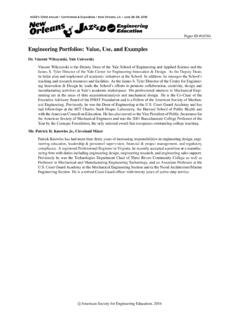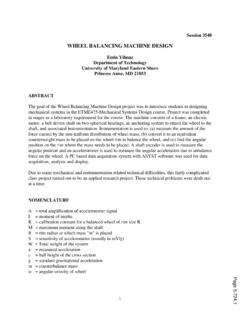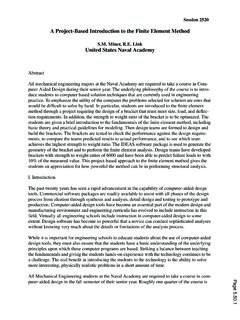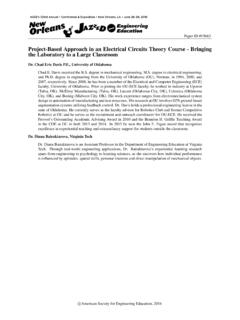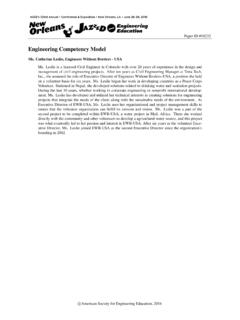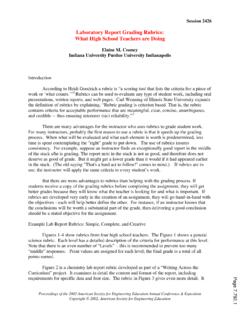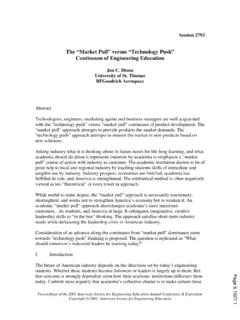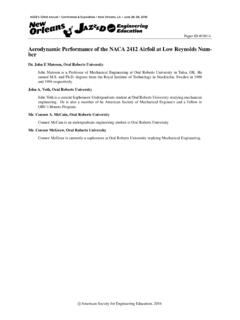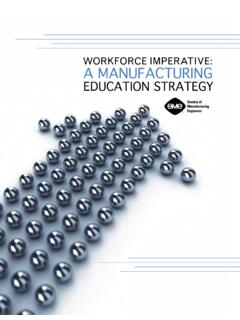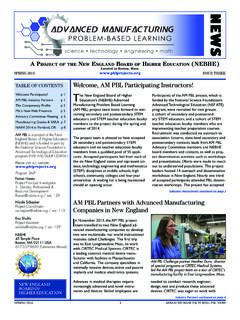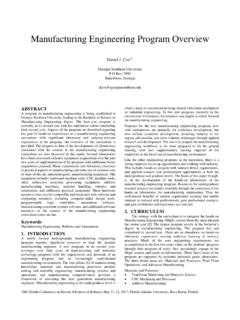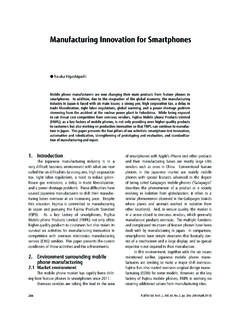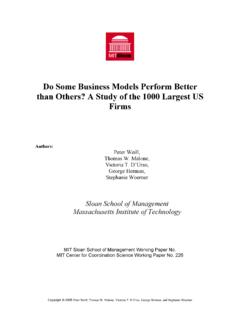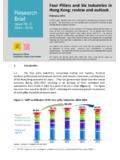Transcription of Conforming a New Manufacturing Engineering Curriculum to ...
1 Paper ID #11272 Conforming a New Manufacturing Engineering Curriculum to the SME FourPillarsDr. Derek M Yip-Hoi, Western Washington UniversityDr. Jeffrey L. Newcomer, Western Washington UniversityDr. Jeffrey L. Newcomer is a Professor of Manufacturing Engineering and Chair of the Engineering andDesign Department at Western Washington University. He received his in Mechanical Engineeringfrom Rensselaer Polytechnic American Society for Engineering Education, 2015 Page a New Manufacturing Engineering Curriculum to the SME four pillars Abstract This paper will highlight the challenges in developing a Manufacturing Engineering Curriculum that conforms to the SME four pillars based on the experiences of the Engineering and Design (ENGD) department at Western Washington University (WWU). These experiences are unique in a number of ways. Foremost, this program was created by transitioning an existing Manufacturing Engineering Technology (MET) program that included an option in CAD/CAM.
2 As a result, the new program was designed to incorporate the strengths of this long established technology program. One of these is hands-on intensive lab experiences within courses that require students to utilize state-of-the-art CAD/CAM technology in support of fabrication activities. Examples of these include classes in Computer-Numerical Control and Mold Making. It was decided in consultation with local industry, that the preservation of these experiences within the new Engineering Curriculum was to remain a key part of the program s and ENGD department s mission. It was also viewed as a way of customizing the new Engineering program to the needs of local and regional industry. This presented significant logistical challenges as the new programs also needed to be configured to satisfy ABET s EAC criteria and program objectives, where design experiences are highly valued.
3 The efforts and results of doing this will be described in this paper. Other unique aspects of these experiences that will be discussed in this paper include the impact of integration with other programs in the ENGD department, in particularly a new program in Plastics and Composites Engineering , the influence of the regional aerospace industry in shaping the Curriculum particularly in the area of composites Manufacturing , and the benefits and challenges of the liberal arts environment at WWU in broadening the experience of students. In addition to the ABET mandated one-year foundation in math and basic science, the new MFGE program has greater depth and breadth when compared to the MET program it has replaced. From the standpoint of the SME four pillars , most of the additional depth is in the areas of Materials and Manufacturing Processes and Product Tooling and Assembly Engineering , and there is a much stronger emphasis on composites Manufacturing .
4 Though these experiences are unique, they will be shown to add support to the recommendation made by Curriculum 2015 that the SME four pillars be followed in developing Manufacturing Engineering curricula. Page The decline of Manufacturing in the United States towards the end of the millennium was of historic proportions, with an estimated trade deficit of around $7 trillion dollars between 2000 and 2010. Evidence suggests that a turnaround is underway as Manufacturing growth has stood out as one of the bright spots in the current economic recovery. The question of why Manufacturing is important to an economy cannot be overstated. Foremost amongst these is that Manufacturing creates jobs. Estimates vary, but each Manufacturing job supports almost three other jobs in other sectors of the economy. It should be noted that the US lags behind other industrial powers in the percentage of its work force dedicated to Manufacturing .
5 Achieving levels similar to Japan and Germany for example translates to between 7 and 8 million new jobs. At the top of this job creation pyramid are engineers that develop the goods, equipment, tooling and facilities that are produced. The downturn at the end of the 20th century precipitated a loss of highly skilled Engineering expertise across a broad swath of American Manufacturing industries including the machine tool and auto industries. Many of those that remained are reaching the age of retirement and will take valuable expertise with them when they leave their companies. For this reason the education of new engineers remains a critical need for many states across the US. As important as this need is, budgetary constraints occurring simultaneously with the economic downturn, have resulted in challenges to four -year schools graduating engineers in sufficient numbers.
6 In particular Manufacturing engineers, whose expertise is best matched to the production of goods, only graduate from fewer than 20 programs here in the United States. Part of the need for Manufacturing engineers is undoubtedly being filled by graduates from Mechanical Engineering programs. There are efforts under way to infuse these curriculums with more Manufacturing However, this is a difficult strategy to follow. The advances in Manufacturing technology particularly those driven by new materials and processes, computerization, the Internet, wireless and portable computing, and globalization are transforming in ever more fast-paced ways, how goods are manufactured. Keeping up with these changes requires not only a dedicated Manufacturing Curriculum , but ones that are customizable to local and regional Manufacturing influences. To address this need in Washington State, a new Manufacturing Engineering program has been created at Western Washington University.
7 This new program resulted from transitioning an existing program in Manufacturing Engineering Technology along with its option in CAD/CAM. This new program accepted its first class of students in 2014 and plans to graduate 24 engineers per year starting in 2017. As part of the development of the Curriculum for this new program, faculty in the department focused heavily on the recommendations from the Curriculum 2015 initiative conducted by the Society of Manufacturing Engineers (SME).3-4 Its primary goal was to examine the state of Manufacturing education in the US and to develop a plan for revising and improving it. Included in the sixteen recommendations were two that encouraged the further development of SME s four pillars of Manufacturing , and its use for Curriculum The four pillars identify the areas of 1) Materials and Manufacturing Processes, 2) Product Tooling and Assembly Engineering , 3) Manufacturing Systems and Operations, and 4) Manufacturing Competitiveness as critical to the knowledge base of a practicing Manufacturing engineer.
8 It is Page at this time to what extent Manufacturing Engineering and technology programs have embraced this template for Curriculum development, though there is evidence that some Creating Manufacturing engineers from Mechanical Engineering programs One strategy for creating Manufacturing engineers is to do so through specialization within a Mechanical Engineering degree. However, significant challenges exist in doing this. The needs of an ABET accredited Mechanical Engineering degree leave little room for the type of in-depth treatment of Manufacturing Engineering relevant subjects. As indicated in the SME Manufacturing Education Plan (MEP) this includes competencies in areas such as Materials, Manufacturing Processes, Product and Process Design, Manufacturing Process Control, Quality, Manufacturing Systems and Supply Chain Management. Mechanical Engineering programs typically include a course on Manufacturing processes.
9 In addition students through electives may be able to specialize in Manufacturing during related areas such as CAD/CAM, CNC, robotics, automation and Manufacturing systems Engineering . Another strategy as described by Waldrop et is to sprinkle Manufacturing related topics and methods throughout traditional mechanical Engineering classes. One example used by these authors is the integration of Design for Manufacture and Assembly (DFMA) principles in an Engineering design class. While both these approaches have merit, it is unlikely that either will close the skill gap given the range of topics and the depth needed to produce a Manufacturing Engineering graduate with the competencies identified by SME. Waldrop et al. also point towards certification as a means for graduates to develop resumes that are commensurate with its employer s expectations. Examples of this include the Society of Manufacturing Engineers certified Manufacturing technologist and engineer examinations.
10 He also however admits that larger companies typically offer academic courses to cover educational gaps in their new employees. One of the deficiencies of all these approaches is that they neglect to give a student a true capstone experience in Manufacturing that empowers them to utilize the design process as it pertains to products processes and systems, and pursuing it within the context of a Manufacturing related problem. Benefits and challenges of creating dedicated Manufacturing Engineering programs A program dedicated specifically to creating a Manufacturing engineer can avoid the problems identified above. The Curriculum can be designed to ensure adequate treatment of the desired competencies for this type of Engineering , and can ensure that the design experiences are rich enough in the appropriate areas. However, there are several challenges that programs face that must be overcome if they wish to become more established.

